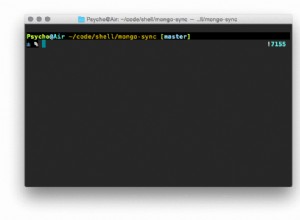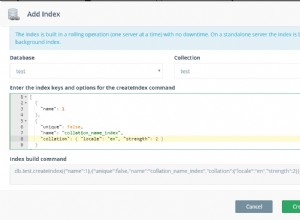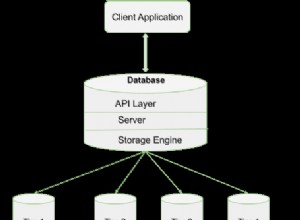Eu acho que esta é uma boa ideia, mas você tem que fazer isso sozinho, não há suporte embutido para isso. Se você tiver uma camada de acesso, poderá fazê-lo lá. Você precisaria de uma classe de atributo, algo assim;
public enum IndexConstraints
{
Normal = 0x00000001, // Ascending, non-indexed
Descending = 0x00000010,
Unique = 0x00000100,
Sparse = 0x00001000, // allows nulls in the indexed fields
}
// Applied to a member
[AttributeUsage(AttributeTargets.Property | AttributeTargets.Field)]
public class EnsureIndexAttribute : EnsureIndexes
{
public EnsureIndex(IndexConstraints ic = IndexConstraints.Normal) : base(ic) { }
}
// Applied to a class
[AttributeUsage(AttributeTargets.Class)]
public class EnsureIndexesAttribute : Attribute
{
public bool Descending { get; private set; }
public bool Unique { get; private set; }
public bool Sparse { get; private set; }
public string[] Keys { get; private set; }
public EnsureIndexes(params string[] keys) : this(IndexConstraints.Normal, keys) {}
public EnsureIndexes(IndexConstraints ic, params string[] keys)
{
this.Descending = ((ic & IndexConstraints.Descending) != 0);
this.Unique = ((ic & IndexConstraints.Unique) != 0); ;
this.Sparse = ((ic & IndexConstraints.Sparse) != 0); ;
this.Keys = keys;
}
}//class EnsureIndexes
Você pode então aplicar atributos no nível de classe ou de membro da seguinte maneira. Descobri que adicionar no nível de membro era menos provável de ficar fora de sincronia com o esquema em comparação com adicionar no nível de classe. Você precisa ter certeza, é claro, de obter o nome real do elemento em oposição ao nome do membro C#;
[CollectionName("People")]
//[EnsureIndexes("k")]// doing it here would allow for multi-key configs
public class Person
{
[BsonElement("k")] // name mapping in the DB schema
[BsonIgnoreIfNull]
[EnsureIndex(IndexConstraints.Unique|IndexConstraints.Sparse)] // name is implicit here
public string userId{ get; protected set; }
// other properties go here
}
e então em sua implementação de acesso ao banco de dados (ou repositório), você precisa de algo assim;
private void AssureIndexesNotInlinable()
{
// We can only index a collection if there's at least one element, otherwise it does nothing
if (this.collection.Count() > 0)
{
// Check for EnsureIndex Attribute
var theClass = typeof(T);
// Walk the members of the class to see if there are any directly attached index directives
foreach (var m in theClass.GetProperties(BindingFlags.Public | BindingFlags.NonPublic | BindingFlags.Instance | BindingFlags.FlattenHierarchy))
{
List<string> elementNameOverride = new List<string>(1);
EnsureIndexes indexAttr = null;
// For each members attribs
foreach (Attribute attr in m.GetCustomAttributes())
{
if (attr.GetType() == typeof(EnsureIndex))
indexAttr = (EnsureIndex)attr;
if (attr.GetType() == typeof(RepoElementAttribute))
elementNameOverride.Add(((RepoElementAttribute)attr).ElementName);
if ((indexAttr != null) && (elementNameOverride.Count != 0))
break;
}
// Index
if (indexAttr != null)
{
if (elementNameOverride.Count() > 0)
EnsureIndexesAsDeclared(indexAttr, elementNameOverride);
else
EnsureIndexesAsDeclared(indexAttr);
}
}
// Walk the atributes on the class itself. WARNING: We don't validate the member names here, we just create the indexes
// so if you create a unique index and don't have a field to match you'll get an exception as you try to add the second
// item with a null value on that key
foreach (Attribute attr in theClass.GetCustomAttributes(true))
{
if (attr.GetType() == typeof(EnsureIndexes))
EnsureIndexesAsDeclared((EnsureIndexes)attr);
}//foreach
}//if this.collection.count
}//AssureIndexesNotInlinable()
AssegureIndexes então se parece com isso;
private void EnsureIndexesAsDeclared(EnsureIndexes attr, List<string> indexFields = null)
{
var eia = attr as EnsureIndexes;
if (indexFields == null)
indexFields = eia.Keys.ToList();
// use driver specific methods to actually create this index on the collection
var db = GetRepositoryManager(); // if you have a repository or some other method of your own
db.EnsureIndexes(indexFields, attr.Descending, attr.Unique, attr.Sparse);
}//EnsureIndexes()
Observe que você colocará isso após cada atualização, porque se você esquecer em algum lugar, seus índices podem não ser criados. É importante garantir, portanto, que você otimize a chamada para que ela retorne rapidamente se não houver indexação a ser feita antes de passar por todo esse código de reflexão. Idealmente, você faria isso apenas uma vez ou, no mínimo, uma vez por inicialização do aplicativo. Então, uma maneira seria usar um sinalizador estático para rastrear se você já fez isso, e você precisaria de proteção de bloqueio adicional em torno disso, mas de forma simplista, parece algo assim;
void AssureIndexes()
{
if (_requiresIndexing)
AssureIndexesInit();
}
Então é o método que você deseja em cada atualização de banco de dados que você fizer, que, se você tiver sorte, também será incorporado pelo otimizador JIT.




